Download PDF
Washington County Conservancy District and St. George Water Services Department
Technology Category
- Functional Applications - Remote Monitoring & Control Systems
- Networks & Connectivity - Network Management & Analysis Software
- Networks & Connectivity - Wireless Local Area Network
Applicable Industries
- Cities & Municipalities
- Utilities
Applicable Functions
- Facility Management
- Maintenance
Use Cases
- Predictive Maintenance
- Remote Asset Management
- Water Utility Management
Services
- Hardware Design & Engineering Services
- System Integration
The Challenge
St. George Water Services Department needed to collect reliable and accurate data from hundreds of I/O points scattered throughout a large and diverse topographical area. They identified that upgrading to a SCADA system would cover a wider area and provide a better overall network capable of transferring data in real time. The first issue was the protocol for transmitting data from one point to another. In the context of wireless M2M data communication, a network protocol is a formal set of rules, conventions, and data structures that govern how computers and other devices exchange information over a network. The 'backbone' is typically a wireless M2M communications technology to allow for many data items to be transmitted bi-directionally at the same time.
About The Customer
Washington County Water Conservancy District (WCWCD) is a non-profit public agency established in 1962 to manage Washington County’s water needs. WCWCD is responsible for reservoirs, pipelines, wells, water storage tanks, treatment plants, hydropower plants, and diversion dams located inside the district. Most of WCWCD water is sold at wholesale to the cities within the district. St. George is one of the cities that purchases water from WCWCD. The mission for the St. George Water Services Department is to effectively and efficiently manage and optimize the complete water cycle for the city of St. George.
The Solution
The St. George Water Services Department utilized FreeWave’s HT-Plus Ethernet spread spectrum radios for the core of their wireless M2M communications network. To minimize cost without sacrificing performance, the city designed a system using FreeWave’s cost-effective RGRIO and FGR series radios to handle single and low I/O data points using the ModBus protocol. These satellite cells were coupled together through a network of HT-Plus Ethernet radios to the Main Control PC that graphically displays the data and logs the important points at predetermined intervals. The HT-Plus radios have two serial ports that allow ‘back links’ for the serial data radios, enabling them to send data without converting it to an Ethernet protocol. The city also used PLCs (Programmable Logic Controllers) at control points and configured those PLCs to communicate through serial ports to ModBus devices using the FGR radios, before connecting to the backbone through TCP/IP ports.
Operational Impact
Quantitative Benefit
Related Case Studies.

Case Study
Turning A Stadium Into A Smart Building
Honeywell created what it called the “intelligent system” for the National Stadium in Beijing, China, turning the venue for the opening and closing events at the 2008 Summer Olympics into a “smart building.” Designed by highly controversial artist Ai Weiwei, the “Bird’s Nest” remains one of the most impressive feats of stadium architecture in the world. The 250,000 square meter structure housed more than 100,000 athletes and spectators at a time. To accommodate such capacity, China turned to Honeywell’s EBI Integrated Building Management System to create an integrated “intelligent system” for improved building security, safety and energy efficiency.

Case Study
IoT Solutions for Smart City | Internet of Things Case Study
There were several challenges faced: It is challenging to build an appliance that can withstand a wide range of voltage fluctuations from as low at 90v to as high as 320v. Since the device would be installed in remote locations, its resilience was of paramount importance. The device would have to deal with poor network coverage and have the ability to store and re-transmit data if networks were not available, which is often the case in rural India. The device could store up to 30 days of data.

Case Study
Automation of the Oguz-Gabala-Baku water pipeline, Azerbaijan
The Oguz-Gabala-Baku water pipeline project dates back to plans from the 1970’s. Baku’s growth was historically driven by the booming oil industry and required the import of drinking water from outside of the city. Before the construction of the pipeline, some 60 percent of the city’s households received water for only a few hours daily. After completion of the project, 75 percent of the two million Baku residents are now served around the clock with potable water, based on World Health Organization (WHO) standards. The 262-kilometer pipeline requires no pumping station, but uses the altitude differences between the Caucasian mountains and the capital to supply 432,000 m³/d to the Ceyranbatan water reservoir. To the people of Baku, the pipeline is “the most important project not only in 2010, but of the last 20 years.”

Case Study
GPRS Mobile Network for Smart Metering
Around the world, the electricity supply industry is turning to ‘smart’ meters to lower costs, reduce emissions and improve the management of customer supplies. Smart meters collect detailed consumption information and using this feedback consumers can better understand their energy usage which in turn enables them to modify their consumption to save money and help to cut carbon emissions. A smart meter can be defined in many ways, but generally includes an element of two-way communication between the household meter and the utility provider to efficiently collect detailed energy usage data. Some implementations include consumer feedback beyond the energy bill to include online web data, SMS text messages or an information display in consumers’ premises. Providing a cost-effective, reliable communications mechanism is one of the most challenging aspects of a smart meter implementation. In New Zealand, the utilities have embraced smart metering and designed cost effective ways for it to be implemented. The New Zealand government has encouraged such a move to smart metering by ensuring the energy legislation is consistent with the delivery of benefits to the consumer while allowing innovation in this area. On the ground, AMS is a leader in the deployment of smart metering and associated services. Several of New Zealand’s energy retailers were looking for smart metering services for their residential and small business customers which will eventually account for over 500,000 meters when the multi-year national deployment program is concluded. To respond to these requirements, AMS needed to put together a solution that included data communications between each meter and the central data collection point and the solution proposed by Vodafone satisfied that requirement.
.png)
Case Study
Smart Street Light Network (Copenhagen)
Key stakeholders are taking a comprehensive approach to rethinking smart city innovation. City leaders have collaborated through partnerships involving government, research institutions and solution providers. The Copenhagen Solutions Lab is one of the leading organizations at the forefront of this movement. By bringing together manufacturers with municipal buyers, the Copenhagen Solutions Lab has catalyzed the development and deployment of next-generation smart city innovations. Copenhagen is leveraging this unique approach to accelerate the implementation of smart city solutions. One of the primary focus areas is LED street lighting.

Case Study
NB-IoT connected smart meters to improve gas metering in Shenzhen
Shenzhen Gas has a large fleet of existing gas meters, which are installed in a variety of hard to reach locations, such as indoors and underground, meaning that existing communications networks have struggled to maintain connectivity with all meters. The meter success rate is low, data transmissions are so far unstable and power consumption is too high. Against this background, Shenzhen Gas, China Telecom, Huawei, and Goldcard have jointly trialed NB-IoT gas meters to try and solve some of the challenges that the industry faces with today’s smart gas meters.




